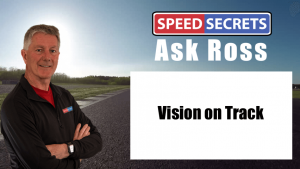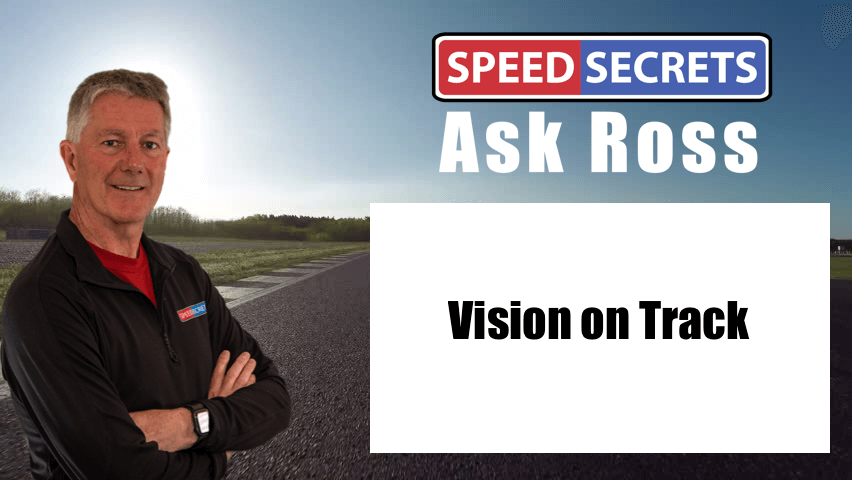 Q: “I feel like I still need a lot of work on my eye placement. I know the rule is to look ahead, but sometimes when people tell me this it feels very vague. I have tried working on looking as far ahead as I can because I have a bad habit of staring at the apex as I turn in. However, sometimes I feel like I look too far ahead where I miss the apex because I can no longer see it. So, I don’t understand the balance, as sometimes looking at the apex feels natural. Exactly how far ahead should I be looking, and at what point does one stop looking at the apex to get their eyes up?”
Q: “I feel like I still need a lot of work on my eye placement. I know the rule is to look ahead, but sometimes when people tell me this it feels very vague. I have tried working on looking as far ahead as I can because I have a bad habit of staring at the apex as I turn in. However, sometimes I feel like I look too far ahead where I miss the apex because I can no longer see it. So, I don’t understand the balance, as sometimes looking at the apex feels natural. Exactly how far ahead should I be looking, and at what point does one stop looking at the apex to get their eyes up?”
A: I spent almost two years researching how the best drivers, as well as athletes in other sports, use their vision. I read research papers, watched videos of drivers using eye tracking devices, interviewed dozens of elite-level drivers, used different approaches with drivers I was coaching, and tried different approaches with my own vision when racing. That led me to developing what I believe is a process that we should use when driving, refining it as I coached other drivers in it, and eventually presenting it in a training webinar I did a couple of years ago. In that webinar, I spent over an hour explaining how it works, and what you should do, so now I’ll try to give you an answer that won’t take you an hour to read!
The process I’m talking involves four steps:
- Mental Vision
- Glance
- Focus
- Peripheral
Prior to you even being able to physically see where you’re going, and what the upcoming section of track looks like, you should be able to “see” it in your mind. Essentially, this is your memory of what it looks like from driving through this section previously, perhaps many, many times. It’s important that you can mentally picture this section before you even get there — this is your Mental Vision.
Next is what you’re really asking about, but there is no simple answer to the question of how far ahead you should look. It’s not like I can tell you to look “157.643 feet ahead”! What I can tell you is that the best drivers Glance ahead, practically as far ahead as they can physically see, although this glance is just that — a quick flick of eyes and vision ahead, and then their Focus comes back to the primary reference point. For example, approaching a brake zone, the eyes should Glance ahead as far as possible, looking into the corner; then they come back to Focusing on a primary reference point, such as the turn-in.
But here’s the thing: the quick Glance ahead may take a fraction of a second, and then you Focus for about two to three times as long on the reference. Then, it’s another Glance ahead, back to the Focus on the primary reference point, another Glance ahead, back to the Focus, Glance, Focus, Glance, Focus, and so on. In other words, your eyes are constantly moving, Glancing ahead, scanning back to the primary Focus, Glance ahead, scanning back to the Focus, etc.
Again, you spend approximately two to three times as long on Focusing on the primary reference as you do Glancing ahead, but even still, you never spend more than a second or so in any other place. That’s what is meant when you’re told to “keep your eyes moving.”
Why the Glance ahead? To give you a mental target, something to aim for, but also to make sure there’s nothing you need to deal with, such as a car that has spun, or a change in track conditions.
Understand that this Glance-Focus sequence is also continually moving ahead at the speed of your car. You don’t focus on one thing, and continue to focus on it until you arrive at it. Instead, the Glancing and Focusing moves ahead constantly, while scanning in between.
Now it’s time to talk about the role of your Peripheral vision. Think of it as your “checking” tool; as you pass a reference, such as an apex, you don’t turn your head and look directly at it with your main Focus. No, as you pass near and by it, your Peripheral picks up how close you are to it, what the position or angle your car is at, and from that, tells you how you’re doing. If you’re a little wide of the apex, it’s your Peripheral vision that lets you know so you can adapt by delaying the initial application of the throttle, for example.
I hope a key take-away from this is that your eyes are constantly moving. It’s not a static thing, it’s dynamic. If you recall those numbered drawings for kids, where if you draw a line from 1 to 2, and then to 3, and then to 4, and then 5… you draw the outline of an animal, or something similar. When a child is first doing this, it’s a series of straight lines that make up the outline. But eventually the child learns to look ahead, planning the direction for the next number or two, and then makes a series of curved lines to get to the end — and the drawing looks more realistic. That’s the way your vision should work when driving on the track. That’s why you use your Mental Vision, Glance ahead, Focus on the next primary reference, and check on your progress with your Peripheral Vision.
By the way, I plan to do another Vision for Drivers webinar soon, so make sure you’re on my email list so I can let you know when I’m doing it (if you’re not already, go to the home page of my website here, and fill in the form for Speed Secrets Randomly).

